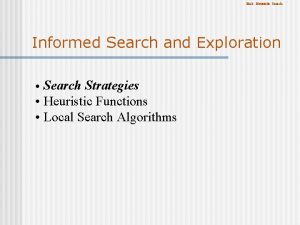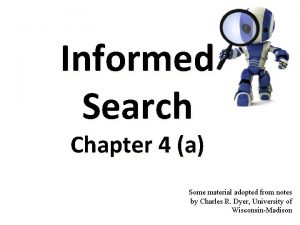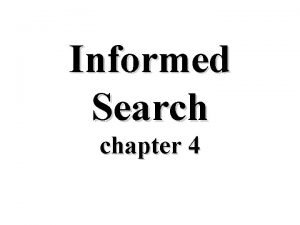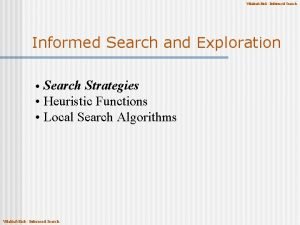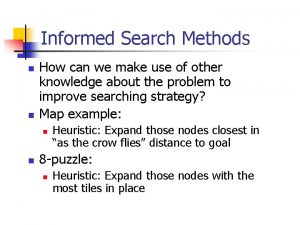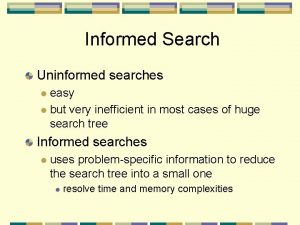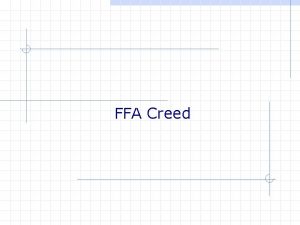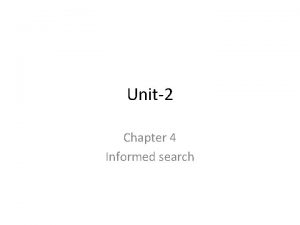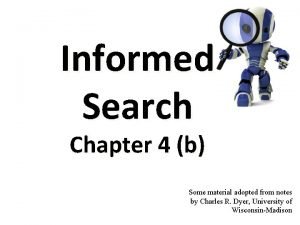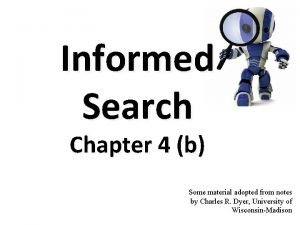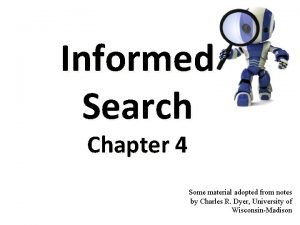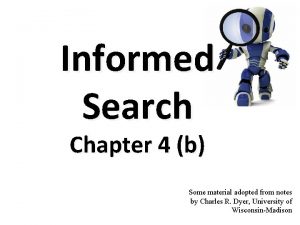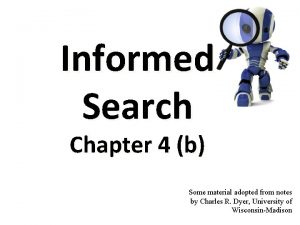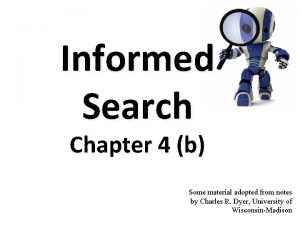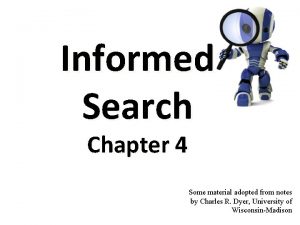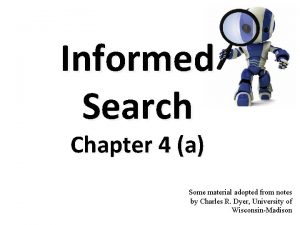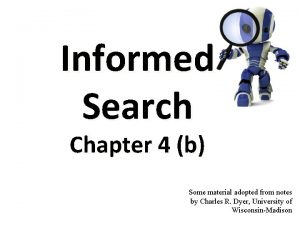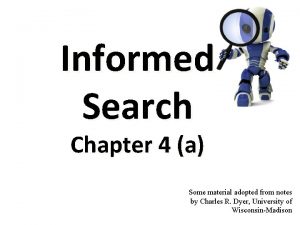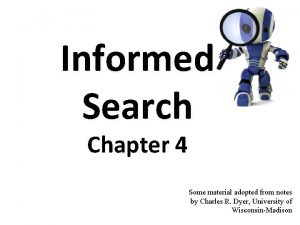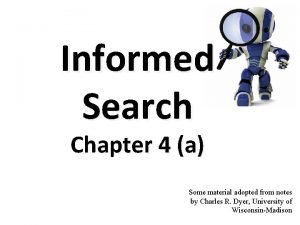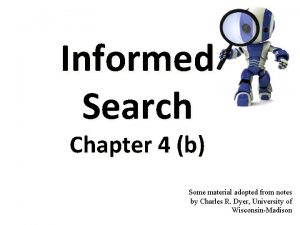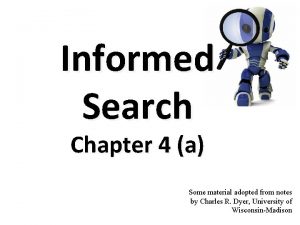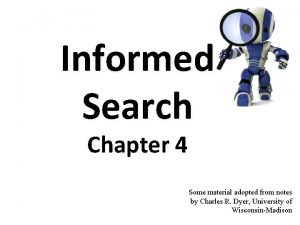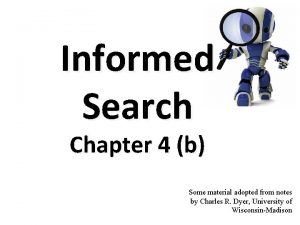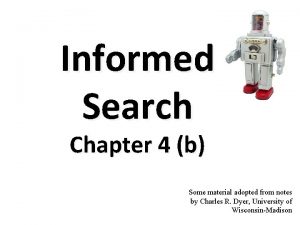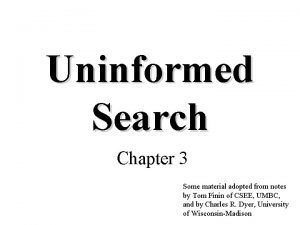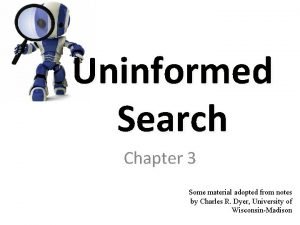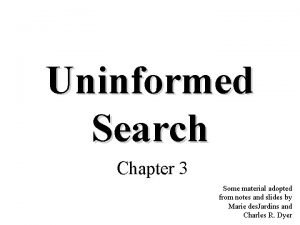Informed Search Chapter 4 a Some material adopted

























- Slides: 25

Informed Search Chapter 4 (a) Some material adopted from notes by Charles R. Dyer, University of Wisconsin-Madison

Today’s class • Heuristic search • Best-first search – Greedy search – Beam search – A, A* – Examples • Memory-conserving variations of A* • Heuristic functions

Big idea: heuristic Merriam-Webster's Online Dictionary Heuristic (pron. hyu-’ris-tik): adj. [from Greek heuriskein to discover] involving or serving as an aid to learning, discovery, or problem-solving by experimental and especially trial-and-error methods The Free On-line Dictionary of Computing (15 Feb 98) heuristic 1. <programming> A rule of thumb, simplification or educated guess that reduces or limits the search for solutions in domains that are difficult and poorly understood. Unlike algorithms, heuristics do not guarantee feasible solutions and are often used with no theoretical guarantee. 2. <algorithm> approximation algorithm. From Word. Net (r) 1. 6 heuristic adj 1: (CS) relating to or using a heuristic rule 2: of or relating to a general formulation that serves to guide investigation [ant: algorithmic] n : a commonsense rule (or set of rules) intended to increase the probability of solving some problem [syn: heuristic rule, heuristic program]

Informed methods add domain-specific information • Add domain-specific information to select best path along which to continue searching • Define heuristic function, h(n), that estimates goodness of node n • h(n) = estimated cost (or distance) of minimal cost path from n to a goal state. • Based on domain-specific information and computable from current state description that estimates how close we are to a goal

Heuristics • All domain knowledge used in search is encoded in the heuristic function, h() • Examples – Missionaries & Cannibals: # people on starting river bank – 8 -puzzle: number of tiles out of place – 8 -puzzle: sum of distances each tile is from its goal • In general – h(n) >= 0 for all nodes n – h(n) = 0 implies that n is a goal node – h(n) = ∞ implies n is a dead-end that can’t lead to a goal

Heuristics for 8 -puzzle Current State The number of misplaced tiles (not including the blank) Goal State 1 2 3 4 7 5 6 8 1 4 7 2 5 8 3 6 In this case, only “ 8” is misplaced, so heuristic function evaluates to 1 In other words, the heuristic says that it thinks a solution might be available in just 1 more move 11 22 33 44 55 66 77 8 8 N N N N Y

Heuristics for 8 -puzzle Manhattan Distance (not including the blank) Current State Goal State 3 2 8 4 7 5 1 6 1 4 7 2 5 8 3 2 spaces 8 3 6 • The 3, 8 and 1 tiles are misplaced (by 2, 3, and 3 steps) so the heuristic function evaluates to 8 • Heuristic says that it thinks a solution is available in just 8 more moves. • The misplaced heuristic’s value is 3 3 3 spaces 8 1 3 spaces 1 Total 8

1 4 7 We can use heuristics to guide search 1 4 7 2 8 6 3 5 In this hill climbing example, the Manhattan Distance heuristic helps us quickly find a solution to the 8 puzzle 1 4 7 goal 1 4 7 2 5 8 3 6 2 8 6 6 3 5 5 1 4 7 2 8 6 3 5 1 4 7 2 8 3 5 6 2 8 7 3 5 6 2 5 8 3 0 h(n) 4 1 6 1 4 7 4 1 4 7 2 8 3 5 6 1 2 4 8 3 5 6 7 2 5 8 3 6 3 2 2 3 1 4 7 2 8 3 5 6 3

1 4 6 In this example, hill climbing doesn’t work! All nodes on fringe 1 4 are taking a step 6 “backwards” (local minima) This puzzle is solvable in just 12 more steps 2 5 3 8 2 5 7 3 8 6 1 4 6 7 7 1 4 2 6 7 h(n) 3 5 8 2 5 7 6 3 5 8 1 4 6 2 5 7 3 8 6

Best-first search • Search algorithm that optimizes depthfirst search by expanding most promising node chosen according to heuristic rule • Order nodes on nodes list by increasing value of an evaluation function, f(n), incorporating domain-specific information • This is a generic way of referring to the class of informed methods

Greedy best first search • A greedy algorithm makes locally optimal choices in hope of finding a global optimum • Uses evaluation function f(n) = h(n), sorting nodes by increasing values of f • Selects node to expand appearing closest to goal (i. e. , node with smallest f value) • Not complete • Not admissible, as in example – Assume arc costs = 1, greedy search finds goal g, with solution cost of 5 – Optimal solution is path to goal with cost 3 a h=2 b h h=4 h=1 c i h=1 d h=1 e h=0 g 2

Beam search • Use evaluation function f(n), but maximum size of the nodes list is k, a fixed constant • Only keep k best nodes as candidates for expansion, discard rest • k is the beam width • More space efficient than greedy search, but may discard nodes on a solution path • As k increases, approaches best first search • Not complete • Not admissible (optimal)

Algorithm A • Use as an evaluation function 0 S f(n) = g(n) + h(n) 8 • g(n) = minimal-cost path from the 5 1 start state to state n 1 8 5 B A C • g(n) term adds “breadth-first” 9 3 component to evaluation function 7 5 1 4 D • Ranks nodes on search frontier by E G estimated cost of solution from 8 start node via given node to goal 9 g(d)=4 • Not complete if h(n) can = ∞ C is chosen next to expand h(d)=9 • Not admissible (optimal)

Algorithm A 1 Put the start node S on the nodes list, called OPEN 2 If OPEN is empty, exit with failure 3 Select node in OPEN with minimal f(n) and place on CLOSED 4 If n is a goal node, collect path back to start and stop 5 Expand n, generating all its successors and attach to them pointers back to n. For each successor n' of n 1 If n’ not already on OPEN or CLOSED • put n' on OPEN • compute h(n'), g(n')=g(n)+ c(n, n'), f(n')=g(n')+h(n') 2 If n’ already on OPEN or CLOSED and if g(n') is lower for new version of n', then: • Redirect pointers backward from n’ on path with lower g(n’) • Put n' on OPEN

Algorithm A* • Pronounced “a star” • Algorithm A with constraint that h(n) <= h*(n) • h*(n) = true cost of minimal cost path from n to a goal • h is admissible when h(n) <= h*(n) holds • Using an admissible heuristic guarantees that 1 st solution found will be an optimal one • A* is complete whenever branching factor is finite and every action has fixed positive cost • A* is admissible Hart, P. E. ; Nilsson, N. J. ; Raphael, B. (1968). "A Formal Basis for the Heuristic Determination of Minimum Cost Paths". IEEE Transactions on Systems Science and Cybernetics SSC 4 4 (2): 100– 107.

Observations on A • Perfect heuristic: If h(n) = h*(n) for all n, then only nodes on an optimal solution path are expanded; no extra work is performed • Null heuristic: If h(n) = 0 for all n, then it is an admissible heuristic and A* acts like uniform-cost search • Better heuristic: If h 1(n) < h 2(n) <= h*(n) for all non-goal nodes, then h 2 is a better heuristic than h 1 – If A 1* uses h 1, and A 2* uses h 2, then every node expanded by A 2* is also expanded by A 1* – i. e. , A 1 expands at least as many nodes as A 2* – We say that A 2* is better informed than A 1* • The closer h to h*, the fewer extra nodes expanded

Example search space 0 S 8 1 3 1 A 8 7 8 5 5 B 4 9 4 4 D 8 E 9 G 0 8 C 3 5

Example search space start state parent pointer 0 S 8 1 3 7 8 5 1 A 8 5 B 4 9 arc cost 4 4 D 8 E 9 G 0 8 C 3 5 h value goal state

Example 1 1 0 1 5 8 4 8 9 8 8 4 3 inf 0 8 9 9 11 inf 9 9 9 4 5 inf 0 A 3 n g(n) h(n) f(n) h*(n) S A B C D E G 8 0 S 4 D 8 E 5 8 B 4 9 7 8 5 8 4 9 G C 5 0 • h*(n) is (hypothetical) perfect heuristic (an oracle) • Since h(n) <= h*(n) for all n, h is admissible (optimal) • Optimal path = S B G with cost 9 3

8 0 S Greedy search 1 1 A 3 f(n) = h(n) 4 D 8 E 5 8 B 4 9 7 8 5 8 4 9 G 5 0 node expanded nodes list { S(8) } S { C(3) B(4) A(8) } C { G(0) B(4) A(8) } G { B(4) A(8) } • Solution path found is S C G, 3 nodes expanded. • See how fast the search is!! But it is NOT optimal. C 3

8 0 S A* search f(n) = g(n) + h(n) 1 1 A 3 4 D 8 E 5 8 B 4 9 7 8 5 8 4 9 G node exp. nodes list { S(8) } S { A(9) B(9) C(11) } A { B(9) G(10) C(11) D(inf) E(inf) } B { G(9) G(10) C(11) D(inf) E(inf) } G { C(11) D(inf) E(inf) } • Solution path found is S B G, 4 nodes expanded. . • Still pretty fast. And optimal, too. 5 0 C 3

Proof of the optimality of A* • Assume that A* has selected G 2, a goal state with a suboptimal solution, i. e. , g(G 2) > f* • Proof by contradiction shows it’s impossible – Choose a node n on an optimal path to G – Because h(n) is admissible, f* >= f(n) – If we choose G 2 instead of n for expansion, then f(n) >= f(G 2) – This implies f* >= f(G 2) – G 2 is a goal state: h(G 2) = 0, f(G 2) = g(G 2). – Therefore f* >= g(G 2) – Contradiction

Dealing with hard problems • For large problems, A* may require too much space • Variations conserve memory: IDA* and SMA* • IDA*, iterative deepening A*, uses successive iteration with growing limits on f, e. g. – A* but don’t consider a node n where f(n) >10 – A* but don’t consider a node n where f(n) >20 – A* but don’t consider a node n where f(n) >30, . . . • SMA* -- Simplified Memory-Bounded A* – Uses queue of restricted size to limit memory use

How to find good heuristics • If h 1(n) < h 2(n) <= h*(n) for all n, h 2 is better than (dominates) h 1 • Relaxing problem: remove constraints for easier problem; use its solution cost as heuristic function • max of two admissible heuristics is an a Combining heuristics: dmissible heuristic, and it’s better! • Use statistical estimates to compute h; may lose admissibility • Identify good features, then use machine learning to find heuristic function; also may lose admissibility

Summary: Informed search • Best-first search is general search where minimum-cost nodes (w. r. t. some measure) are expanded first • Greedy search uses minimal estimated cost h(n) to goal state as measure; reduces search time, but is neither complete nor optimal • A* search combines uniform-cost search & greedy search: f(n) = g(n) + h(n). Handles state repetitions & h(n) never overestimates –A* is complete & optimal, but space complexity high –Time complexity depends on quality of heuristic function –IDA* and SMA* reduce the memory requirements of A*
 What is informed search and uninformed search
What is informed search and uninformed search Best first search is a type of informed search which uses
Best first search is a type of informed search which uses Informed (heuristic) search strategies
Informed (heuristic) search strategies Informed search example
Informed search example Time and space complexity of uninformed search
Time and space complexity of uninformed search Examples of informed search
Examples of informed search 8 puzzle python
8 puzzle python Greedy search
Greedy search Informed and uninformed search
Informed and uninformed search Normal loss treatment in process costing
Normal loss treatment in process costing Author of the ffa creed
Author of the ffa creed Republic act no 55 agrarian reform
Republic act no 55 agrarian reform Unit cost meaning
Unit cost meaning Public law 740 passed by congress
Public law 740 passed by congress Ffa official dress
Ffa official dress Cudd and dudd is the part of drug disribution system for..
Cudd and dudd is the part of drug disribution system for.. Process adopted for curriculum development in pakistan
Process adopted for curriculum development in pakistan Who wrote the ffa creed
Who wrote the ffa creed The institute of management accountants adopted the ______.
The institute of management accountants adopted the ______. What are the first 2 words of the ffa creed paragraphs
What are the first 2 words of the ffa creed paragraphs The method of unit costing is adopted by
The method of unit costing is adopted by Conventional representation of threads
Conventional representation of threads When was the ffa creed adopted and amended
When was the ffa creed adopted and amended Managerial accounting skills are ______.
Managerial accounting skills are ______. They say sometimes you win some
They say sometimes you win some They say it only takes a little faith to move a mountain
They say it only takes a little faith to move a mountain


